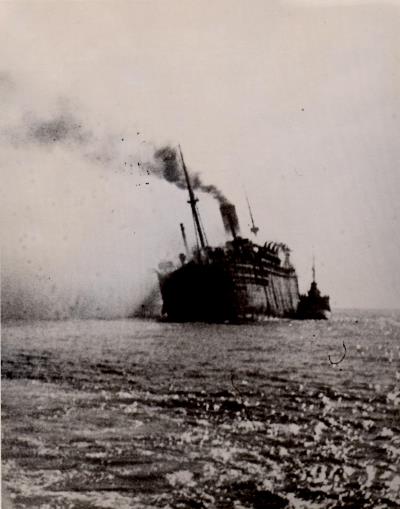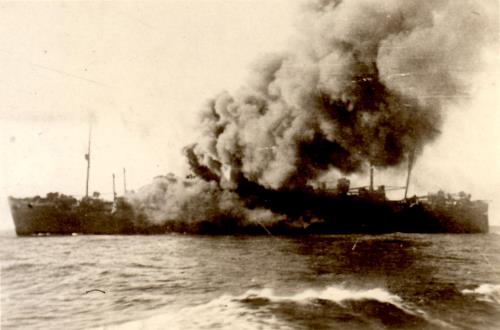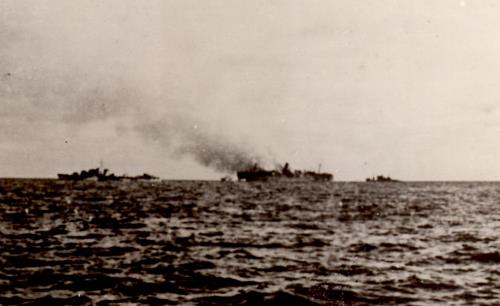Strathallan
British Troop transport

Photo courtesy of Allan C. Green Collection
| Name | Strathallan | ||
| Type: | Troop transport | ||
| Tonnage | 23,722 tons (one of the largest ships sunk). | ||
| Completed | 1938 - Vickers-Armstrongs Ltd, Barrow-in-Furness | ||
| Owner | P. & O. Steam Navigation Co Ltd, London | ||
| Homeport | London | ||
| Date of attack | 21 Dec 1942 | Nationality: | |
| Fate | Sunk by U-562 (Horst Hamm) | ||
| Position | 36° 52'N, 0° 34'W - Grid CH 8171 | ||
| Complement | 5122 (16 dead and 5106 survivors). | ||
| Convoy | KMF-5 | ||
| Route | Glasgow (11 Dec) - Gibraltar (20 Dec) - Algiers | ||
| Cargo | Troops and military stores | ||
| History | Completed in March 1938. On 4 Feb 1940, the steam passenger ship was requisitioned by the Ministry of War Transport (MoWT) as troopship. In November 1942 participated in Operation Torch, the landings in North Africa. | ||
| Notes on event | At 02.23 hours on 21 Dec 1942, U-562 fired a spread of four torpedoes at convoy KMF-5 about 40 miles north of Oran and heard two detonations after 65 seconds and another after 5 minutes 50 seconds. However, only the ship of convoy commodore, the Strathallan (Master John Henry Biggs), was hit by one torpedo which struck on port side in the engine room. The explosion killed two engineer officers and two Indian crewmen on watch below, damaged the bulkhead separating the engine and boiler rooms and fractured a tank causing oil to enter the boiler room. The ship immediately developed a 15° list to port and the master ordered the nurses and troops to abandon ship in calm seas in the four motor boats, 16 lifeboats and rafts. All got away, except one lifeboat that had been damaged by the explosion and another that could not be launched due to the list. After it became clear that the ship would not sink fast, the evacuation was stopped and the troops ordered to the starboard side to help the stability. The about 1300 survivors in the boats and on rafts were picked up in the morning by HMS Verity (D 63) (Lt J.C. Rushbrooke, DSC, RN) and taken to Oran. After two hours of work, at about 06.00 hours, HMS Laforey (G 99) (Capt R.M.J. Hutton, DSO, RN) took the Strathallan in tow for Oran at a speed of 5-6 knots. Shortly after midday about 2000 survivors were transferred to HMS Panther (G 41) (LtCdr Viscount Jocelyn, RN) and HMS Pathfinder (G 10) (Cdr E.A. Gibbs, DSO and Bar, RN) and taken to Oran. It appeared as tough the ship could be saved as HMS Restive (W 39) (Lt D.M. Richards, RNR) went alongside to assist the pumping, but at 13.15 hours oil came in contact with the hot boilers and the fumes exploded, sending flames up through the funnel. The ship was soon ablaze amidships so the master ordered the ship to be abandoned. All men went aboard the tug except a skeleton crew and were then transferred to HMS Laforey because HMS Restive continued to tow the burning ship slowly towards Oran for 14 hours, but she capsized to port and sank 12 miles off Oran in 36°01N/00°33W at about 04.00 hours on 22 December. The Strathallan had 440 crew members, 26 gunners, 248 Queen Alexandra nurses and 4408 British and American troops (among them 296 officers, some possibly of the Headquarter staff of the 1st US Army) on board. Of this number, only six crew members, five nurses and five troops were lost. The master John Henry Biggs was awarded the CBE and the Lloyds War Medal for bravery at sea. Photos of the sinking Strathallan: | ||
| More info | |||
| On board | We have details of 48 people who were on board. | ||
If you can help us with any additional information on this vessel then please contact us.



